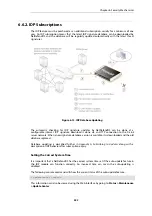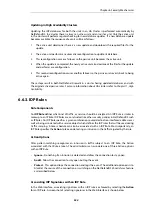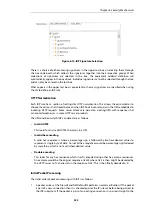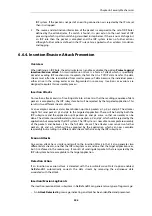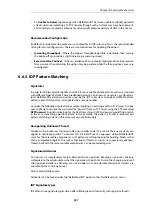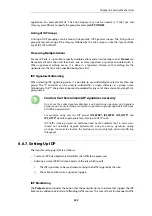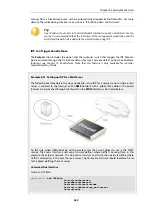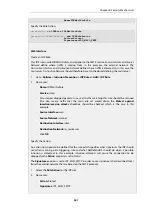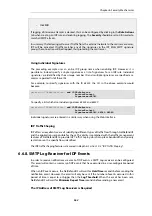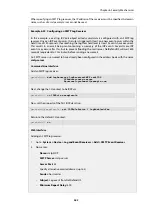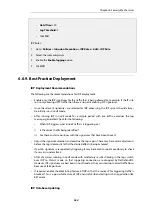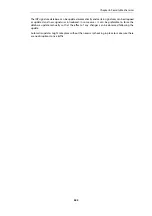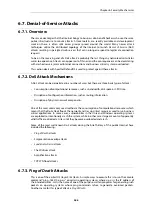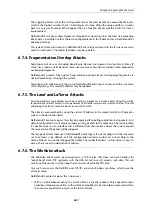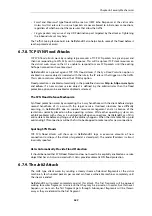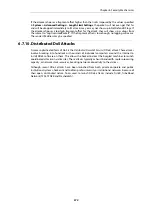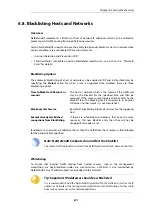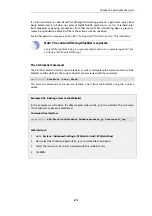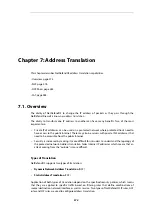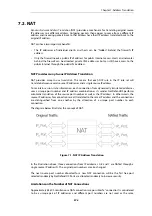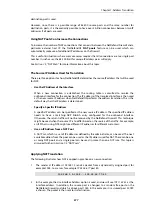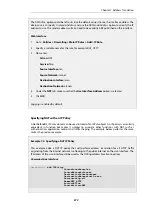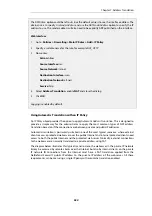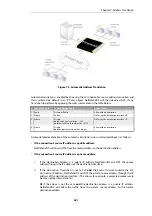
The triggering factor is that the last fragment makes the total packet size exceed 65535 bytes,
which is the highest number that a 16-bit integer can store. When the value overflows, it jumps
back to a very small number. What happens then is a function of how well the victim's IP stack is
implemented.
NetDefendOS will never allow fragments through that would result in the total size exceeding
65535 bytes. In addition to that, there are configurable limits for IP packet sizes in NetDefendOS's
advanced settings.
This type of attack will show up in NetDefendOS event logs as drops with the IP rule name set to
LogOversizedPackets
. The sender IP address may be spoofed.
6.7.4. Fragmentation Overlap Attacks
Teardrop and its cousins (including Bonk, Boink, Nestea) are
Fragment Overlap Attacks
. Many IP
stacks have shown erratic behavior (excessive resource exhaustion or crashes) when exposed to
overlapping fragments.
NetDefendOS protects fully against fragmentation overlap attacks. Overlapping fragments are
never allowed to pass through the system.
Teardrop and its followers will show up in NetDefendOS event logs as drops with the rule name
set to
IllegalFrags
. The sender IP address may be spoofed.
6.7.5. The Land and LaTierra Attacks
Land and LaTierra type attacks work by sending a packet to a victim and making the victim
respond back to itself, which in turn generates yet another response to itself and so on. This will
either bog the victim's machine down, or cause it to crash.
The attack is accomplished by using the victim's IP address in the source field of an IP packet as
well as in the destination field.
NetDefendOS protects against this attack by applying IP spoofing protection to all packets. In its
default configuration, it will simply compare arriving packets to the contents of the routing table;
if a packet arrives on an interface that is different from the interface where the system expects
the source to be, the packet will be dropped.
These type of attacks show up in NetDefendOS event logs as IP rule set drops with the rule name
set to
AutoAccess
, by default, or if the configuration contains custom
Access Rule
objects, the
name of the access rule that dropped the packet. The sender IP address is of no interest since it is
always the same as the destination IP address.
6.7.6. The WinNuke attack
The WinNuke attack works by connecting to a TCP service that does not have handlers for
"out-of-band" data (TCP segments with the URG bit set), but still accepts such data. This will
usually put the service in a tight loop that consumes all available CPU time.
One such service was the NetBIOS over TCP/IP service on Windows machines, which gave the
attack its name.
NetDefendOS protects against this in two ways:
•
With a careful inbound policy, the attack surface is greatly reduced. Only exposed services
could possibly become victims to the attack, and public services tend to be more well-written
than services expected to only serve the local network.
Chapter 6: Security Mechanisms
567
Summary of Contents for NetDefendOS
Page 30: ...Figure 1 3 Packet Flow Schematic Part III Chapter 1 NetDefendOS Overview 30 ...
Page 32: ...Chapter 1 NetDefendOS Overview 32 ...
Page 144: ...Chapter 2 Management and Maintenance 144 ...
Page 284: ...Chapter 3 Fundamentals 284 ...
Page 392: ...Chapter 4 Routing 392 ...
Page 419: ... Host 2001 DB8 1 MAC 00 90 12 13 14 15 5 Click OK Chapter 5 DHCP Services 419 ...
Page 420: ...Chapter 5 DHCP Services 420 ...
Page 573: ...Chapter 6 Security Mechanisms 573 ...
Page 607: ...Chapter 7 Address Translation 607 ...
Page 666: ...Chapter 8 User Authentication 666 ...
Page 775: ...Chapter 9 VPN 775 ...
Page 819: ...Chapter 10 Traffic Management 819 ...
Page 842: ...Chapter 11 High Availability 842 ...
Page 866: ...Default Enabled Chapter 13 Advanced Settings 866 ...
Page 879: ...Chapter 13 Advanced Settings 879 ...

